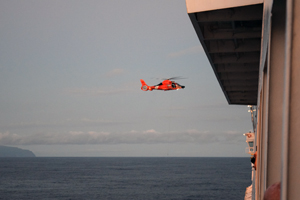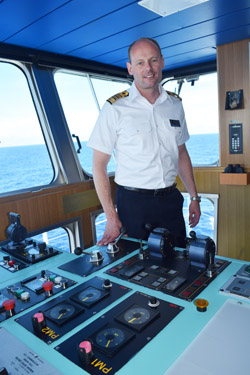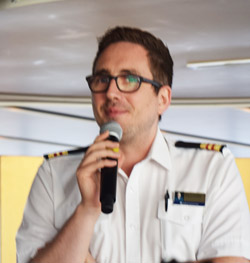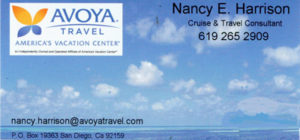Editor’s Note: This is the 35th in a series of stories researched during Don and Nancy Harrison’s 50th Wedding Anniversary cruise from Sydney, Australia, to San Diego. Previous installments of the series, which runs every Thursday, may be found by tapping the number of the installment:1, 2,3,4, 5, 6, 7,8, 9, 10, 11, 12,13, 14,15, 16, 17, 18,19,20, 21, 22, 23, 24, 25, 26, 27, 28, 29, 30, 31, 32, 33, 34
By Donald H. Harrison

AT SEA, Aboard MS Maasdam – Over the public address system of our cruise ship one Monday afternoon, we heard the ominous announcement “Bright Star,” followed by the location “Cabin 20.” A few hours later, approximately at 5 p.m., Captain Arno Jutten, master of our vessel, announced that there had been a medical emergency aboard, and that it would be necessary to turn the Maasdam around to bring it in reach of a Coast Guard rescue helicopter stationed in Hawaii. As we had left Hawaii approximately at 11 p.m. the night before, that meant that we would have to retrace most of the last 18 hours that our ship had been underway.
Neither Captain Jutten nor any of his officers and crew offered any more immediate information about what had happened, but passengers were able to piece together some of the details. An accident of some sort had befallen a woman who occupied a Neptune Suite on Deck 10, the Navigation Deck. Neptune Suites are more luxurious than ordinary cabins on the Maasdam. According to a ship’s brochure, Neptune Suites “feature floor-to-ceiling glass windows with a door that opens to a private verandah, two lower beds that convert to a king-sized bed, large sitting area with sofa bed, dressing room, and private bathroom with dual sink vanity, shower stall and full-sized whirlpool tub. All staterooms include bathrobes, Elemis bath amenities, complimentary fresh fruit, flat-panel TV and DVD player, personal safe, telephone and hair dryer.”
In addition, Neptune Suite occupants receive “complimentary laundry and dry cleaning, oversize bath towels, corsages and boutonnieres for formal night, hors d’ouevres before dinner, binoculars for use on the cruise, cocktail party with ship officers, priority boarding, priority dining and seating requests, daily breakfast service, high tea service in-suite, and access to the Neptune Lounge.”
In other words, the passenger who was injured had been receiving VIP treatment.
As we returned to Hawaii, passengers speculated about what might have happened to the woman, and also how delayed Maasdam might be before arriving in San Diego, the final port of our 39-day journey from Sydney, Australia . Nancy, being a travel agent, was not concerned, even though we had a very critical appointment planned on the same day that we had been scheduled to arrive in San Diego. We were supposed to meet with Rabbi Josh Dorsch at Tifereth Israel Synagogue and some friends for a renewal-of-vows ceremony in celebration of our 50th wedding anniversary.
Given such an important appointment, how could Nancy remain so calm? She explained that Maasdam’s original itinerary allocated six days for the Pacific Ocean crossing between Honolulu and San Diego. She pointed out that we have been on other cruises in which the crossing was accomplished in five days—and those were fairly leisurely trips. If Captain Jutten decided to cruise at a faster speed across the Pacific, she said, we’d be there in plenty of time. I never doubt Nancy, my Madam Travel Agent.

The next morning, a helicopter that I later learned was a Coast Guard MH-65 Dolphin from the Barbers Point Coast Guard Station on Maui lowered a basket to an upper, open deck of our ship. A helicopter crew member jumped out and assisted the passenger and then a doctor into the basket, which then was raised to the helicopter. According to subsequent news reports, we were 190 miles northwest of Maui. The patient, aged 68, was delivered in a 40-minute flight to Queen’s Medical Center in Honolulu where, according to a Coast Guard press release, she was treated for a head injury.
The press release did not name the victim, and even was vague about the identity of our cruise ship. According to the news release, “Watchstanders at the Joint Rescue Coordination Center Honolulu received a request from the captain of the Netherlands-flagged cruise ship Monday afternoon. At 4:41 p.m., JRCC contacted Sector Honolulu to coordinate the medevac with air station. At 6:21 p.m., the helicopter arrived at the scene and lowered a rescue swimmer…”
The Coast Guard news release also offered some self-congratulations: “This is a textbook medevac illustrating our operational readiness and dedication of our service the people,” it said, quoting Chief Warrant Officer Greg Babst. “Our crews train regularly for situations like this to ensure safe and efficient responses to get people to the care they need.”
It may have been routine for the Coast Guard, which later sent the helicopter back to the ship to pick up the rescue swimmer who had given up his place on the chopper in favor of the doctor, but it was anything but routine for the passengers, who from various vantage points on the ship videotaped and photographed the helicopter hovering over the ship. Besides hoping for the full recovery of our fellow passenger, we felt somewhat badly for the rescue swimmer, who—if the helicopter hadn’t been able to return for him—would have received a free, luxury cruise to San Diego.

At 9 a.m. on that next Tuesday morning, Captain Jutten announced that he had received clearance from the Holland-America home office to proceed to San Diego at a speed of 20 knots, which would enable us to arrive in San Diego at the scheduled time on Sunday morning. This was not a decision made without economic consequences: the faster the cruise ship goes, the less efficiently does it utilize its fuel. The scuttlebutt around the ship was that this would increase Holland America’s expenses for this voyage by $30,000.
During a “Meet the Crew” Q&A session a few days later, passengers were able to question Nurse Jay Fitzgerald about what had occurred that day the passenger had struck her head. On cruises in which Maasdam sails through remote locations or has a lot of sea dates, the ship carries a complement of two doctors and three nurses, he said.
“There are many procedures involved,” Fitzgerald told us. “A lot of departments are involved in the coordination of the heli-medi evacuation. Our main priority is obviously the patient… as we are responsible for identifying their illness or injury and making sure that they are going to gain by initiating the evacuation. If the patient is not going to gain anything by an evacuation to a land hospital, then it is safer to keep them on board the ship. So, we need to identify if there is a real need to take that person off the ship as quickly as we can. So, that’s all that we do. We then speak to the captain and our medical shoreside department to make sure that they agree. It then comes down to the deck officers, the captain, and our coordination center based in Seattle [Washington] and they will make arrangements. They will decide if it is feasible. If we turn around, like we did, and we were out of fuel before we get to San Diego, no one is going to be happy. So, we need to make sure that we have enough fuel on board, we need to make sure that we can do it safely. So, it all depends on the waves, the sea state, and how far the helicopter is going to have to fly.”

A passenger asked if having a member of the ship’s medical team escort the passenger on the helicopter meant that there was now a shortage of medical personnel on the ship. “Unfortunately, we do not get that person back,” Fitzgerald responded, expressing confidence that the remaining doctor and nurses could meet any subsequent medical challenge. “We have to send one of our doctors in the helicopter. The U.S. Coast Guard doesn’t provide medical personnel; they provide rescue swimmers, so it would have been unsafe and unethical to not send a medical escort for a med-evac flight in a helicopter with all the things going on with this person.”
There was a discrepancy between what Nurse Jay told us and the press release sent out by the Coast Guard. The latter had identified the person accompanying the injured woman as a nurse, not as a doctor.
Asked who pays for the med-evac flight, Fitzgerald said the U.S. Coast Guard absorbs the costs for U.S. citizens, but foreign nationals must pay the costs of their evacuation. As there were numerous passengers from other countries aboard, this news was greeted with some moans of disappointment, although other countries have similar policies for non-nationals.
Fitzgerald said he has been told the cost of a helicopter evacuation may typically range between $25,000 and $50,000. He added that, “Most countries will ask you for payment upfront for a helicopter, and that obviously is difficult to do. But Holland-America is not going to leave you stranded. If we need to get you off the ship because you are going to benefit from it, we will essentially pay that for you and then claim it back from yourselves or from your insurance company.” As for coverage once the patient arrives at a land hospital, “When you do leave the ship, before you go we will speak to your travel insurance [agency] and make sure that you have a case open, and you’ve got a number to ring …”
 Fitzgerald said that Holland-America Line would “follow up quite closely with the receiving medical facility and with the family involved.” He added that, “We have a family assistance team based in Seattle, so if we were to disembark you from the ship, they would be in touch with you quite quickly to find out 1) how you are and 2) if there is anything we can do for you. There are port agents with whom we work quite closely, and they would visit this passenger daily or twice daily if they need to. They would be their point of contact should there be problems with their hotel, should there be problems in the hospital, or should there be any concerns, or simply so they have someone to visit them who will become a familiar face…. That’s what we try to do for these people.”
Fitzgerald said that Holland-America Line would “follow up quite closely with the receiving medical facility and with the family involved.” He added that, “We have a family assistance team based in Seattle, so if we were to disembark you from the ship, they would be in touch with you quite quickly to find out 1) how you are and 2) if there is anything we can do for you. There are port agents with whom we work quite closely, and they would visit this passenger daily or twice daily if they need to. They would be their point of contact should there be problems with their hotel, should there be problems in the hospital, or should there be any concerns, or simply so they have someone to visit them who will become a familiar face…. That’s what we try to do for these people.”
Given that the rescue helicopter was small, did that mean that the spouse or traveling companion has to cruise on, and that the patient will be left alone? Fitzgerald responded that depends on where in the world the accident occurs. “Some of the helicopters are bigger and can take the next of kin, or the whole family, depending on where we are,” he said. However, “in Hawaii, we only have the small Dolphin helicopters and they can only take 5 people with one lying down. So, unfortunately the other person is left behind.”
When Queen’s Medical Center in Honolulu was contacted to learn if the passenger recovered, Lisa Seklya responded that “due to Federal Privacy laws, we cannot acknowledge or provide information on a patient without appropriate consent.” As the name of the patient was not released by either the cruise line nor the hospital, consent was all but impossible to obtain. However, I can tell you that the ship’s personnel expended every effort to help her.
*
Harrison is editor of San Diego Jewish World. He may be contacted via donald.harrrison@sdjewishworld.com
Pingback: Don’t panic, stay in the moment, therapist counsels | San Diego Jewish World